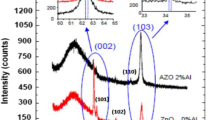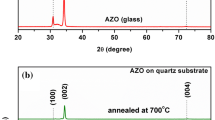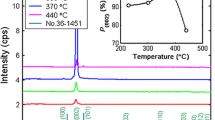Abstract
The fabrication of an efficient electron transport layer (ETL) with high conductivity and transparency is of significant interest. Aluminum doped zinc oxide (AZO) is an established ETL candidate due to its excellent conductivity and transparency, especially in the visible–near infrared (Vis–NIR) spectral range. Herein, we attempt to understand AZO properties by both experimental and computational approaches, as far as these methodologies permit. As part of our approach, we have deposited AZO thin films using radio frequency sputtering technique under two different sets of conditions, batch-I (150, 175, and 200 W; 0.2 mTorr; 20 min) and batch-II (70 W; 2 mTorr; 75 min). And, we have studied the structural, morphological, topographical, electrical, and optical properties of thus deposited films. The results are complemented by first-principles calculations based on the density functional theory (DFT) performed over a 2 × 2 × 2 and 3 × 2 × 2 supercell of wurtzite ZnO, to assess the effect of one aluminum atom substitution on the structural, electronic, and optical properties of the solid. We could discuss, thus, obtained computational results by comparing with the experimental measurements through a reliable construction of aluminum doping percentage models (3.12 and 2.08 at.%).









Similar content being viewed by others
References
M. Schmidt, A. Falco, M. Loch, P. Lugli, G. Scarpa, AIP Adv. (2014). https://doi.org/10.1063/1.4899044
M. Souadaa, C. Louagea, J.Y. Doisya, L. Meuniera, A. Benderraga, B. Ouddaneb, S. Bellayera, N. Nunsc, M. Traisnela, U. Maschke, Ultrason. Sonochem. (2018). https://doi.org/10.1016/j.ultsonch.2017.08.043
C. ViolBarbosaa, J. Karela, J. Kissa, O.D. Gordanb, S.G. Altendorfc, Y. Utsumia, M.G. Samantc, Y.H. Wud, K.D. Tsueid, C. Felsera, S.S.P. Parkinc, Proc. Natl. Acad. Sci. USA (2016). https://doi.org/10.1073/pnas.1611745113
A. Karalis, J.D. Joannopoulos, Sci. Rep. (2017). https://doi.org/10.1038/s41598-017-13540-8
J. Ghosha, R. Ghosha, P.K. Giri, Sens. Actuators B (2018). https://doi.org/10.1016/j.snb.2017.07.110
B.T. Camic, F. Oytun, M.H. Aslan, H.J. Shin, H. Choi, F. Basarir, J Colloid Interface Sci. (2017). https://doi.org/10.1016/j.jcis.2017.05.065
S.Q. Hussain, C. Yen, S. Khan, G.D. Kwon, S. Kim, S. Ahn, A.H. Tuan Le, H. Park, S. Velumani, J. Yi, Mater. Sci. Semicond. Process. (2015). https://doi.org/10.1016/j.mssp.2015.02.024
S. Khan, S. Qamar Hussain, D. Hwang, S. Velumani, H. Lee, Mater. Sci. Semicond. Process. (2015). https://doi.org/10.1016/j.mssp.2015.01.019
L. Schmidt-Mende, J.L. MacManus-Driscoll, Mater. Today (2007). https://doi.org/10.1016/S1369-7021(07)70078-0
H. Zhu, Y. Feng, L. Zhang, B. Lai, T. He, D. Liu, Y. Wang, J. Yin, Y. Ma, Y. Huang, H. Jia, Y. Mai, Phys. Status Solidi A (2012). https://doi.org/10.1002/pssa.201127746
R.R. Biswal, S. Velumani, B.J. Babu, A. Maldonado, S.T. Guerrac, L. Castaneda, M.D.L.L. Olvera, Mater. Sci. Eng. B (2010). https://doi.org/10.1016/j.mseb.2010.03.013
V. Bhosle, J.T. Prater, F. Yang, D. Burk, S.R. Forrest, J. Narayan, J. Appl. Phys. (2007). https://doi.org/10.1063/1.2750410
C. Besleaga, L. Ion, V. Ghenescu, G. Soco, A. Radu, L. Arghir, C. Florica, S. Antohe, Thin Solid Films (2012). https://doi.org/10.1016/j.tsf.2012.07.030
B. Santoshkumar, A. Biswas, S. Kalyanaraman, R. Thangavel, G. Udayabhanu, G. Annadurai, S. Velumani, Superlattices Microstruct. (2017). https://doi.org/10.1016/j.spmi.2017.03.039
H. AitDads, S. Bouzit, L. Nkhaili, A. Elkissani, A. Outzourhit, Sol. Energy Mater. Sol. Cells (2016). https://doi.org/10.1016/j.solmat.2015.09.063
M.L. Grilli, A. Sytchkova, S. Boycheva, A. Piegari, Phys. Status Solidi A (2013). https://doi.org/10.1002/pssa.201200547
Y.B. Li, Y. Bando, D. Golberg, Appl. Phys. Lett. (2004). https://doi.org/10.1063/1.1738174
B. Yun Oh, M.C. Jeong, T.H. Moon, W. Lee, J.M. Myounga, J. Appl. Phys. (2006). https://doi.org/10.1063/1.2206417
P. Jood, R.J. Mehta, Y. Zhang, G. Peleckis, X. Wang, R.W. Siegel, T.B. Tasciuc, S.X. Dou, G. Ramanath, Nano Lett. (2011). https://doi.org/10.1021/nl202439h
T.R. Ramireddy, V. Venugopal, J.B. Bellam, A. Maldonado, J. Vega-Pérez, S. Velumani, M.D.L.L. Olvera, Materials (2012). https://doi.org/10.3390/ma5081404
B.P. Zhang, K. Wakatsuki, N.T. Binh, N. Usami, Y. Segawa, Thin Solid Films (2004). https://doi.org/10.1016/S0040-6090(03)01466-4
A.N. Gruzintsev, V.T. Volkov, L.N. Matveeva, Russ. Microlectron. (2002). https://doi.org/10.1023/A:1015415120927
A.C. Gâlcă, M. Secu, A. Vlad, J.D. Pedarnig, Thin Solid Films (2010). https://doi.org/10.1016/j.tsf.2009.12.041
N. Srinatha, Y.S. No, V.B. Kamble, S. Chakravarty, N. Suriyamurthy, B. Angadi, A.M. Umarjif, W.K. Choib, RSC Adv. (2016). https://doi.org/10.1039/c5ra22795j
T. Schuler, T. Krajewski, I. Grobelsek, M.A. Aegerter, Thin Solid Films (2006). https://doi.org/10.1016/j.tsf.2005.07.246
B.J. Babu, A. Maldonado, S. Velumani, R. Asomoza, Mater. Sci. Eng. B (2010). https://doi.org/10.1016/j.mseb.2010.03.010
P. Raghu, N. Srinatha, C.S. Naveen, H.M. Mahesh, B. Angadi, J. Alloys Compd. (2017). https://doi.org/10.1016/j.jallcom.2016.09.290
B. Yun Oh, M.C. Jeong, W. Lee, J.M. Myoung, J. Cryst. Growth (2005). https://doi.org/10.1016/j.jcrysgro.2004.10.026
Y. Wang, C. Wang, Z. Peng, Q. Wang, X. Fu, Surf. Rev. Lett. (2017). https://doi.org/10.1142/S0218625X18500063
J.V. Kumar, A. Maldonado, Y. Matsumato, M.L. Olvera, ICEEE (2014). https://doi.org/10.1109/ICEEE.2014.6978324
J.W. Kim, H.B. Kim, J. Korean Phys. Soc. (2011). https://doi.org/10.3938/jkps.59.2349
M. Bououdina, S. Azzaza, R. Ghomri, M.N. Shaikh, J.H. Dai, Y. Song, W. Song, W. Cai, M. Ghers, RSC Adv. (2017). https://doi.org/10.1039/c7ra01015j
P.K. Jain, M. Salim, Mater. Res. Express (2017). https://doi.org/10.1088/2053-1591/aa6f99
A. Abbassi, H. Ez-Zahraouy, A. Benyoussef, Opt. Quant. Electron. (2015). https://doi.org/10.1007/s11082-014-0052-7
M.D. Segall, P.J.D. Lindan, M.J. Probert, C.J. Pickard, P.J. Hasnip, S.J. Clark, M.C. Payne, J. Phys.: Condens. Matter (2002). https://doi.org/10.1088/0953-8984/14/11/301
J.P. Perdew, K. Burke, M. Ernzerhof, Phys. Rev. Lett. (1996). https://doi.org/10.1103/PhysRevLett.77.3865
B.G. Pfrommer, M. Côté, S.G. Louie, M.L. Cohen, J. Comp. Phys. (1997). https://doi.org/10.1006/jcph.1996.5612
L. Zhifang, C. Guangyu, G. Shibin, D. Lingling, Y. Rong, M. Yuan, G. Ted, L. Liwei, J. Semicond. (2013). https://doi.org/10.1088/1674-4926/34/6/063004
D. Vanderbilt, Phys. Rev. B (1990). https://doi.org/10.1103/PhysRevB.41.7892
E. Nichelatti, J. Opt. A (2002). https://doi.org/10.1088/1464-4258/4/4/306
A.J. Read, R.J. Needs, Phys. Rev. B (1991) .https://doi.org/10.1103/PhysRevB.44.13071
T. Blanton, International Centre for Diffraction Data, Newtown Square (2014)
J.P. Kar, S. Kim, B. Shin, K.I. Park, K.J. Ahn, W. Lee, J.H. Cho, J.M. Myoung, Solid State Electron. (2010). https://doi.org/10.1016/j.sse.2010.07.002
H. Kim, C.M. Gilmore, J.S. Horwitz, A. Piqué, H. Murata, G.P. Kushto, R. Schlaf, Z.H. Kafafi, D.B. Chrisey, Appl. Phys. Lett. (2000). https://doi.org/10.1063/1.125740
O. Szabó, S. Kováčová, V. Tvarožek, I. Novotný, P. Šutta, M. Netrvalová, D. Rossberg, P. Schaaf, Thin Solid Films (2015). https://doi.org/10.1016/j.tsf.2015.04.009
F. Tran, P. Blaha, Phys. Rev. Lett. (2009). https://doi.org/10.1103/PhysRevLett.102.226401
J.I. Pankove, Optical Processes in Semiconductors. (Dover, New York, 1971)
K.C. Park, D. Young Ma, K.H. Kim, Thin Solid Films (1997). https://doi.org/10.1016/S0040-6090(97)00215-0
Y. lgasaki, H. Saito, J. Appl. Phys. (1991). https://doi.org/10.1063/1.349258
M. Raposo, Q. Ferreira, P.A. Ribeiro, A. Méndez-Vilas, J. Díaz (eds.), Modern Research and Educational Topics in Microscopy (FORMATEX, Portugal, 2007), p. 548
L.C. Damonte, G.N. Darriba, M. Rentería, J. Alloys Compd. (2018). https://doi.org/10.1016/j.jallcom.2017.11.072
F. Marcillo, L. Villamagua, A. Stashans, Int. J. Mod. Phys. B (2017). https://doi.org/10.1142/S0217979217501119
Acknowledgements
The authors are thankful to Consejo Nacional de Ciencia y Tecnología (The National Council of Science and Technology- CONACYT-Mexico) for providing the financial support with the Project No. 263043. Author S. K wish to thank CONACyT for the doctoral fellowship. S.K and S.C would like to thank V. K. Jayaraman and Jorge Sergio Narro-Rios for their invaluable inputs. We wish to thank, F. Alvarado-Cesar (XRD & SEM), M. Galvan-Arellano (UV–vis spectroscopic and Hall effect measurements), N. I. Gonzalez (Gold Masking), and M. G. Ramirez (AFM) for their technical support.
Author information
Authors and Affiliations
Corresponding author
Rights and permissions
About this article
Cite this article
S., K., Ríos-Ramírez, J.J., Chakaravarthy, S. et al. Electrical, optical, and topographical properties of RF magnetron sputtered aluminum-doped zinc oxide (AZO) thin films complemented by first-principles calculations. J Mater Sci: Mater Electron 29, 15383–15395 (2018). https://doi.org/10.1007/s10854-018-8920-8
Received:
Accepted:
Published:
Issue Date:
DOI: https://doi.org/10.1007/s10854-018-8920-8




